

What Is the Bystander Effect? If you witnessed an emergency happening right before your eyes, you would certainly take some sort of action to help the person in trouble, right?

While we might all like to believe that this is true, psychologists suggest that whether or not you intervene might depend upon the number of other witnesses present. Bystander Effect. What Is the Bystander Effect? The Science of Empathy. How Diffusion of Responsibility Affects Group Behavior. Diffusion of responsibility is a psychological phenomenon in which people are less likely to take action when in the presence of a large group of people.1 For example, imagine that you are in a large city on a bustling street.

You notice a man fall to the ground and start convulsing as if having a seizure. Many people turn and look at the man, but no one moves to help or call for medical assistance. Why? Because there are so many people present, no one person feels pressured to respond. Ethics Defined: Diffusion of Responsibility. Bystander intervention in emergencies diffusion of responsibility. Pluralistic Ignorance (SOCIAL PSYCHOLOGY) - iResearchNet.
Pluralistic Ignorance Definition Pluralistic ignorance occurs when people erroneously infer that they feel differently from their peers, even though they are behaving similarly.

As one example, imagine the following scenario: You are sitting in a large lecture hall listening to an especially complicated lecture. After many minutes of incomprehensible material, the lecturer pauses and asks if there are any questions. No hands go up. You look around the room. Another case of pluralistic ignorance that is familiar to many college students concerns drinking on campus. Pluralistic Ignorance and Social Dynamics Pluralistic ignorance plays a role in many other dysfunctional social dynamics. Pluralistic Ignorance and Social Norms Pluralistic ignorance begins with widespread conformity to social norms—norms that govern appropriate behavior in the classroom, at a party, in a boardroom, or in a hospital; norms that regulate behavior with friends, strangers, or colleagues. References: O’Gorman, H. Pluralistic ignorance and social change new 1027. 6 Ways Bullying Impacts Bystanders. Watching another person being bullied can have a huge impact.

After all, most people are bothered when they see someone injured or insulted. In fact, witnessing bullying creates a wide range of emotions and stresses that can take a toll on the bystander. From anxiety and uncertainty, to fear and guilt, bullying significantly impacts bystanders.1 In fact, preliminary research suggests that kids who witness bullying may be as much at risk psychologically as the victims and the bullies.2 And much like victims of bullying, their physical health, mental health, and even academics can be affected.
Here are six ways bystanders are impacted by bullying. Why we still look away: Kitty Genovese, James Bulger and the bystander effect. More than half a century later, the death of Kitty Genovese continues to remind us of the disconnect between what we believe about ourselves and how we really act under pressure.
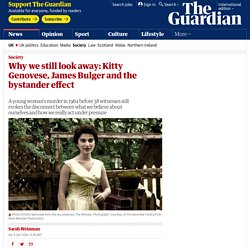
The murder of the 28-year-old outside her apartment in the Queens neighborhood of Kew Gardens in the early morning of 13 March 1964 rippled through New York City and around the world. How could a young, independent woman who lived on her own terms be so easily struck down? How could so many neighbors look on and turn away as she was stabbed repeatedly on the street and in her apartment building? What did that collective inability to act reveal about ourselves, our communities, and our belief systems? Genovese’s killer, Winston Moseley, died in prison this week, bringing the case and its implications back into the spotlight. TODAYonline: Bystanders should stop taking photos and videos of accidents and victims. I refer to the news reports of the fatal traffic accident on Sunday (Dec 29) at Lucky Plaza.
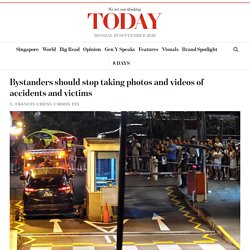
I applaud the Good Samaritans who unselfishly helped to lift up the car, pulled the victims out and attended to them. These are acts of true heroism. 10 Notorious Cases of the Bystander Effect. The bystander effect is the somewhat controversial name given to a social psychological phenomenon in cases where individuals do not offer help in an emergency situation when other people are present.
The probability of help has in the past been thought to be inversely proportional to the number of bystanders. In other words, the greater the number of bystanders, the less likely it is that any one of them will help. This list describes the prototype of the effect and cites nine particularly heinous examples. The Parable of The Good Samaritan First, the prototype of the bystander effect. How to Break the Bystander Effect. They could have left it to someone else.
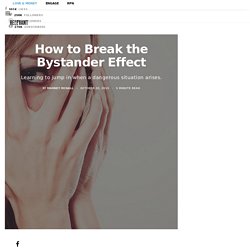
An Army veteran blocked a shooter in Oregon from entering his classroom. Three friends on a high-speed train from Paris to Amsterdam helped stop a gunman wielding an AK-47. This past spring, an Army captain in North Carolina pulled a couple to safety after a fiery car crash. Were these men instinctively courageous, or had they learned to be? The Army captain (aptly wearing a Captain America T-shirt) credited his military training for knowing what to do and remaining calm. These heroes are dramatic examples. And this conundrum is not limited to thwarting terrorism or physically saving someone.
5 steps for overcoming the crippling "bystander effect". Given the choice, Kitty Genovese would rather not have become the subject of social psychology research.
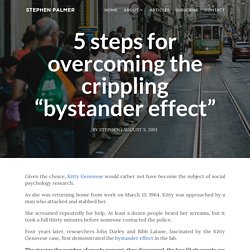
As she was returning home from work on March 13, 1964, Kitty was approached by a man who attacked and stabbed her. She screamed repeatedly for help. At least a dozen people heard her screams, but it took a full thirty minutes before someone contacted the police. Four years later, researchers John Darley and Bibb Latane, fascinated by the Kitty Genovese case, first demonstrated the bystander effect in the lab. How to Overcome the Bystander Effect. Psychologists have long been interested in exactly why and when we help other people.
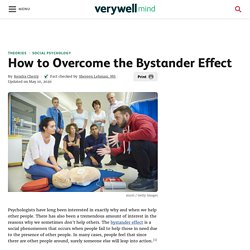
There has also been a tremendous amount of interest in the reasons why we sometimes don't help others. The bystander effect is a social phenomenon that occurs when people fail to help those in need due to the presence of other people. In many cases, people feel that since there are other people around, surely someone else will leap into action.1 While the bystander effect can have a negative impact on prosocial behavior, altruism and heroism, researchers have identified a number of different factors that can help people overcome this tendency and increase the likelihood that they will engage in helping behaviors.2 Some of these include: Witnessing Helping Behavior Sometimes just seeing other people doing something kind or helpful makes us more willing to help others. Imagine that you are walking into a large department store.
Being Observant Being Skilled and Knowledgeable Guilt Feeling Good. The Bystander Effect - You Can Break the Cycle. Underage Kids Ask For A Lighter. What Would You Do: Sales clerk refuses to sell clothes to transgender woman. What Would You Do: Muslim Teen Bullied By Peers. Child Predator Finds A Target.